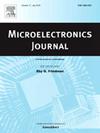Reliability analysis of PoP stacked solder joints under thermal cycling load based on the optimal equivalent model
IF 1.9
3区 工程技术
Q3 ENGINEERING, ELECTRICAL & ELECTRONIC
引用次数: 0
Abstract
An optimal equivalent model for PoP-stacked solder joints is developed based on the nonlinear load-deformation response. The thermal stress distribution of solder joints in PoP assembly arrays subjected to thermal cycling loads is simulated and analyzed. The thermal fatigue failure modes of critical solder joints in the array are discussed, and the thermal fatigue life of these joints is calculated. Furthermore, the influence of structural parameters on solder joint thermal stress is elucidated. The results indicate that the incorporation of the optimal equivalent model not only improves the efficiency of simulation analysis but also enhances the accuracy of solder joint thermal stress prediction. The solder joints in the lower array of the PoP assembly experience higher thermal stress compared to those in the upper array. Solder joints at the corners of the array exhibit higher thermal stress and are identified as critical components. Cracks initially nucleate at the interface between the solder joint and the copper pad, propagating along the interface and eventually appearing within the solder joint. The thermal fatigue life of critical solder joints in the upper array is 3–4 times longer than that of the critical solder joints in the lower array. The ranking of the influence of specific structural parameters on solder joint thermal stress is as follows: solder joint height > solder joint diameter > PCB thickness > substrate thickness. Thermal stress in solder joints exhibits a negative correlation with solder joint height and diameter, and a positive correlation with PCB and substrate thickness.
求助全文
约1分钟内获得全文
求助全文
来源期刊

Microelectronics Journal
工程技术-工程:电子与电气
CiteScore
4.00
自引率
27.30%
发文量
222
审稿时长
43 days
期刊介绍:
Published since 1969, the Microelectronics Journal is an international forum for the dissemination of research and applications of microelectronic systems, circuits, and emerging technologies. Papers published in the Microelectronics Journal have undergone peer review to ensure originality, relevance, and timeliness. The journal thus provides a worldwide, regular, and comprehensive update on microelectronic circuits and systems.
The Microelectronics Journal invites papers describing significant research and applications in all of the areas listed below. Comprehensive review/survey papers covering recent developments will also be considered. The Microelectronics Journal covers circuits and systems. This topic includes but is not limited to: Analog, digital, mixed, and RF circuits and related design methodologies; Logic, architectural, and system level synthesis; Testing, design for testability, built-in self-test; Area, power, and thermal analysis and design; Mixed-domain simulation and design; Embedded systems; Non-von Neumann computing and related technologies and circuits; Design and test of high complexity systems integration; SoC, NoC, SIP, and NIP design and test; 3-D integration design and analysis; Emerging device technologies and circuits, such as FinFETs, SETs, spintronics, SFQ, MTJ, etc.
Application aspects such as signal and image processing including circuits for cryptography, sensors, and actuators including sensor networks, reliability and quality issues, and economic models are also welcome.
 求助内容:
求助内容: 应助结果提醒方式:
应助结果提醒方式:


